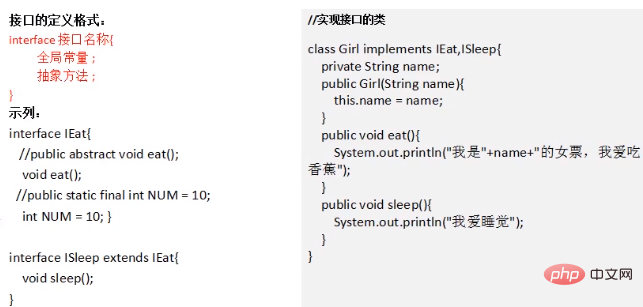
Use interface to define an interface. Interface definitions are similar to similar definitions and are also divided into interface declarations and interface bodies. The interface body consists of two parts: constant definition and method definition. The basic format for defining an interface is as follows:
[修饰符] interface 接口名 [extends 父接口名列表]{
[public] [static] [final] 常量; //全局常量
[public] [abstract] 方法; //抽象方法
}Description:
Modifier: Optional, used to specify the access permission of the interface, the optional value is public. If omitted the default access permissions are used.
Interface name: A required parameter, used to specify the name of the interface. The interface name must be a legal Java identifier. Generally, capital letters are required.
extends Parent interface name list: Optional parameter, used to specify which parent interface the interface to be defined inherits from. When using the extends keyword, the parent interface name is a required parameter.
Methods: The methods in the interface are only defined but not implemented.
java video tutorial recommendation: java learning

##public abstract void eat(); //Interface Only abstract methods can be defined in
void eat(); //The methods defined in the interface do not declare modifiers, and the default is public abstract
public static final int NUM = 10; //Define a constant in the interface
int NUM = 10; //Constant
The concept of interface
1. An interface is a set of behavioral specifications and definitions without implementation (JDK1.8 default method)2. Using interfaces can make our programs More conducive to change3. Interface is one of the essence of ideas in object-oriented programming system4. Object-oriented design rules: based on interface programmingInterface Usage rules
(1) To define an interface, use the interface keyword; (2) In an interface, only constants and abstract methods can be defined, which can be done after JDK1.8 Define the default implementation method; (3) The interface can inherit multiple interfaces, extends xxx, xxx; (4) A concrete class implements the interface using the implements keyword; (5) A class can implement multiple interfaces; (6) The abstract implementation interface does not need to implement the methods of the interface; (7) The methods defined in the interface do not declare access Modifier, the default is public; (8) The interface cannot have a constructor method; (9) The interface cannot be instantiated. Recommended related articles and tutorials:The above is the detailed content of How to define an interface in java. For more information, please follow other related articles on the PHP Chinese website!